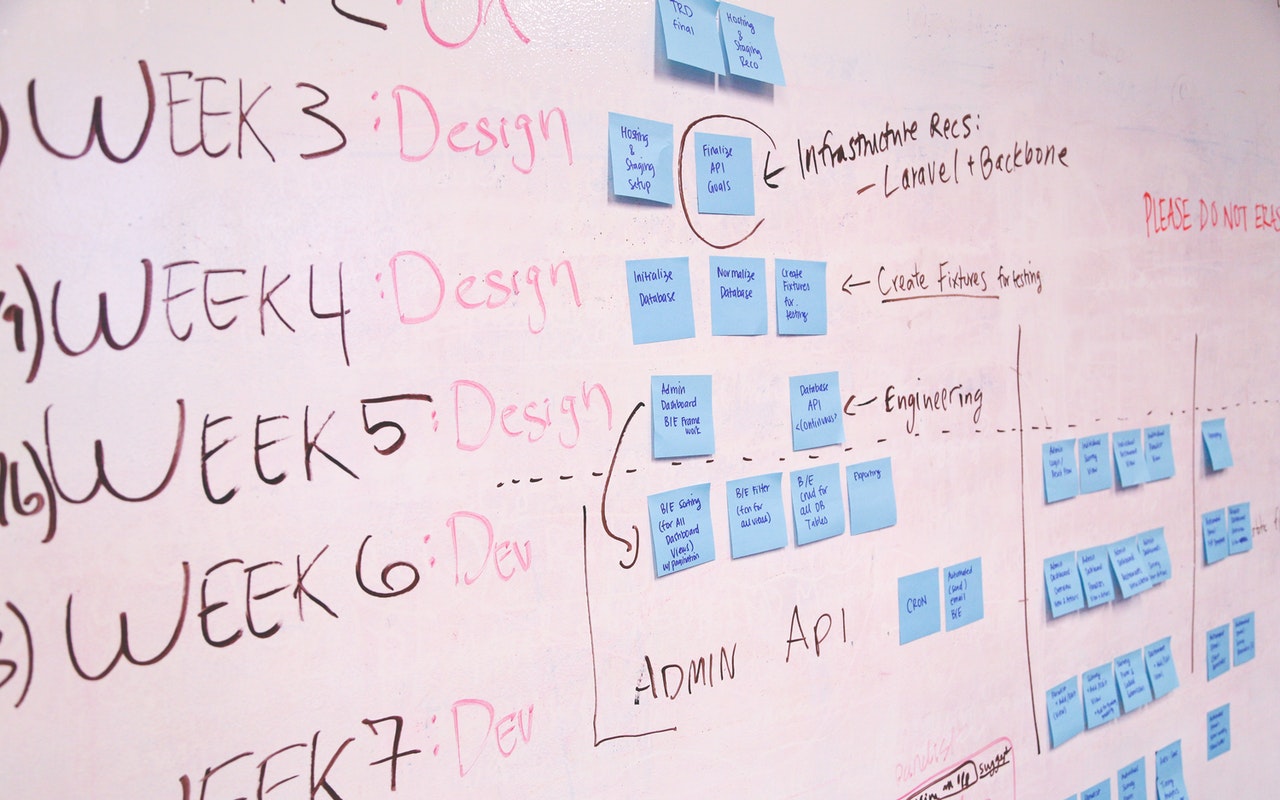Category: Resources
It is no secret that software outsourcing has become an integral part of the modern business world. The ability to get work done without having to hire more employees, or spend time on training new hires, can be a huge boon for any company looking to increase its bottom line.
However, outsourcing comes with its own set of challenges, and it is important to establish a successful outsourcing strategy before you get started.
If you are interested in outsourcing your software development but aren’t sure where to start, here are eight steps that will help you get set up for success.
What is software development outsourcing?


Let’s start with the basics. Software development outsourcing refers to hiring a company, or an individual programmer, that is based outside of your business’s home country. It has become increasingly popular over the last decade, due to a number of factors including:
- The rise of talent available around the world – Software development has become an increasingly popular and rewarding career over the past decade, and as a result, more qualified professionals are available to work on software development projects around the world.
- Imminent access to global markets – Thanks to the Internet and globalization, companies can now reach new partners and customers around the world with little effort. Outsourcing websites or freelance platforms make it easy to find developers in other countries who can get started on your project right away.
- Increased Focus on Cost-Effectiveness – In tough economic times, businesses are looking for new and innovative ways to cut costs without sacrificing quality or service. Outsourcing software development can be a great way to achieve this goal.
- Greater Flexibility – Outsourcing allows businesses to hire programmers when they need them, rather than having full-time employees that may not be needed on a day-to-day basis. It also allows for more specialization, as companies can find developers with specific skillsets to work on their projects.
Due to all these factors, more and more businesses are turning to outsourcing as a way to get their software development projects done.
What is an outsourcing strategy?
An outsourcing strategy is an outline for how you intend to manage your outsourced development. It includes the following:
- Plans for hiring remote developers – This can include plans on where you will find these programmers, what language they should be familiar with, and any other requirements that must be met in order to work on your project.
- Project management plan – This includes how you will communicate with your developers, what tools and documentation you will provide them, and any other instructions they need to complete the project.
- Quality assurance plan – This outlines how you will test and quality control the work that is done by your outsourced team.
- Financial plan – This includes an estimate of how much the project will cost, how you will pay your developers, and any other related financial considerations.
Once you have created an outsourcing strategy, it is important to follow it closely in order to ensure a successful project.
How do I set up a successful software outsourcing strategy?


Now that we know what an outsourcing strategy is, let’s talk about how you can create one for your business. There are many different things to consider when setting up an outsourcing strategy, but here are some of the most important factors:
Define your goals
Before you start, you need to understand what is your end goal for this project. What are you hoping to achieve by outsourcing your development? Is it to save money, increase efficiency, reach new markets, or something else entirely?
Will you be using the team and outsourced developers in the future, or will you just hire them to do a specific task right now? Find out what success looks like before you start working with an outsourced team. Once you know what you want to accomplish, you can start outlining the steps necessary to make that happen.
Research outsourcing partners
The next step is to find a good outsourcing partner. This can be done by conducting research online or through referrals from other businesses. It is important to find a company that has experience in your specific industry and with the type of project you are looking for.
Make sure to ask the potential partner about their quality assurance procedures, communication methods, and any other requirements that are important to you.
Choose the outsourcing model
The next step is to choose the outsourcing model that will work best for your project. There are three main models to consider:
– The first is called “Offshore Development”, where you hire a team of developers in a foreign country to work on your project. This can be a good option if you are looking for lower costs, but you should be aware of the cultural differences and language barriers that can occur. However, if an agency is set up correctly, outsourcing abroad may be the best option in terms of price/quality ratio.
– The second model is “Nearshore Development,” which is similar to offshore development, but with developers located in a nearby country. This can help reduce some of the communication and cultural barriers, but it can still be expensive compared to the first options.
– The third option is called “Onshore,” where you hire a team of developers located in your own country. This generally tends to be the most expensive option, but it can be preferable for those who want in-person communication and want to avoid any potential cultural barriers.
Prepare the necessary documentation
Once you have chosen the outsourcing model that is best for your business, it’s time to prepare any necessary documentation so that your developers are ready to work. This includes contracts, work instructions, payment details, non-disclosure agreements, etc.
Be as clear and specific as possible with your instructions so that there is no confusion about what you want done. It is important to have a contract with your outsourced team because it will help you avoid any legal issues in the future. Make sure that the terms of this agreement are clearly defined and check their references before signing anything.
Decide on your budget
It is crucial to have a clear understanding of how much money you can spend when hiring an outsourced team for development work. This will help determine what type of developers you can hire, the locations they should be located in, and whether or not certain features would be possible for your project.
Create a project plan and timeline
Create a project plan that includes the specific tasks, milestones and deadlines for each phase of your development. This is especially important if you are trying to do more than just one task with an outsourced team, as it can be difficult to keep track of multiple projects at once without planning ahead.
A good project plan will also include specific instructions for outsourced developers, as well as a communication plan so everyone is on the same page. Having a detailed timeline will help to keep your project on track and avoid any costly delays.
Build strong communication channels
One of the most important aspects of a successful outsourcing project is communication. Make sure to have strong communication channels in place, both with your developers and with other teams within your company.
Tools like video conferencing, chat software and file-sharing can help make communication easier, but it’s also important to set up regular check-ins to ensure everyone is on track.
Quality assurance plan
It is important to have a plan in place for quality assurance (QA) when outsourcing development work. This can be done by creating a checklist of items that need to be tested before the project is considered complete, and by having someone on your team specifically responsible for QA.
This person should regularly communicate with developers to ensure that all QA tasks are being completed on time and that the finished product meets your expectations.
Conclusion
Outsourcing development work can be a great way to get high-quality results at a fraction of the cost, but it’s important to take the time to plan your project carefully. By following these tips, you can set up a successful outsourcing strategy that will help your business grow.
Now that you have some idea of what is involved in the process of setting up an outsourcing strategy, it’s time to start planning it and see what works best for your business.
If you want a reputable and reliable team to help you with your next software development project, schedule a free consultation call with us today. Our team consists of dedicated and experienced developers that can assist you with all of your software development needs. We would be happy to discuss your needs and see how we can help.
Today web development is a complex and in-demand field. Almost any company, regardless of size or industry, needs a well-functioning website to compete and succeed. So it’s no surprise that more and more businesses are turning to web developers to create and maintain their online presence.
But assembling a top-notch development team is easier said than done. There are a lot of factors to consider, and it can be tough to find all the right people with the necessary skills. You have to take into account everything from the type of people you are looking for, to where they are located.
If you are assembling a web development team from scratch, you might be filled with various questions. Where do you start? How do you find the most qualified candidates for your site’s needs? Where can you look to hire great people that fit into both your budget and time frame requirements?
Don’t worry, we’ve all been there. To make this journey much easier, we’ve compiled a list of the most frequently asked questions about web development, and provided answers – so it can serve as a go-to resource for you.
What is web development?
Web development is a broad term that refers to the work that goes into creating websites from scratch. It includes tasks such as coding, designing and testing sites before they go live.
Who are web developers?
Web developers are the people who design, code and test websites. They come from a variety of backgrounds, but most have knowledge of coding languages such as HTML, CSS and JavaScript.
Web developers can be divided into two main categories: front-end and back-end.
- Front-end developers are responsible for the website’s appearance, its “look and feel.” They are in charge of things like color schemes, font styles and the general layout. This role requires a high degree of creativity as well as technical skills.
- Back-end developers are responsible for tasks such as database management and website security. They are also responsible for integrating third-party services with a site, such as social media platforms or payment gateways.
What skills do web developers need?


There are a number of skills that are essential for successful web development. Most developers have a strong background in coding, but they also need to be familiar with different platforms and software. They should be able to work independently as well as part of a team, and be comfortable working with clients.
Here are some of the most important skills that web developers need to possess.
- Knowledge of HTML, CSS and Javascript – The first step is knowing how to write the basic code behind every website. These are some of the technologies used by most front-end devs, regardless of what platform they work on or their specialization.
- Front-end development skills – A good front-end developer needs to be creative and have a strong understanding of how websites are displayed in different browsers. They should also be up-to-date on the latest trends and technologies in this field.
- Back-end development skills – Back-end developers work with different coding languages and frameworks. They should be familiar with PHP, Ruby on Rails, Laravel and Express.JS.
- Understanding of web hosting and server administration – In order to build and maintain a website, developers need to know how websites are hosted and what the different components are. This includes understanding things like domain names, DNS servers and FTP clients.
- Knowledge of popular CMSs (content management systems) – A content management system (CMS) is a platform that allows users to edit and update content on their website. Developers need to know how these platforms work, as well as which ones are the most popular with clients.
- Understanding of mobile web development – It’s important for developers to understand what factors affect the user experience when browsing websites from different devices. They should be familiar with popular mobile frameworks like React Native and Ionic, as well as responsive design principles.
How do you know if you need a website or not?
This is an important question to answer before considering hiring a web developer. Every company or brand must have an online presence. The long-term answer to the question is that a website will undoubtedly be needed at some point in the future.
However, If you are a small business just starting out, you may be able to get away with a simple Facebook or Instagram page.
It all depends on your use case, but keep in mind that sooner or later you will want to grow your business and the only way to do that is by showing up in Google search results with your website.
Where to find web developers?
Now that you know what skills are required for a successful web development team, the next step is finding the right people to fill those roles.
There are a number of places where you can find qualified developers, including online job boards, classified websites and social media. You can also reach out to local development agencies or tech meetups in your area.
The best way to find the right developer for your team is to launch a wide net and interview as many candidates as possible. This will allow you to assess more potential hires and find the right person for your business.
However, this can not only be overwhelming but also expensive. That is why many companies turn to outsourcing. This allows them to find the right talent at a lower cost without spending too much time and money. Because of this, outsourcing became an important business practice for small, medium, and large businesses alike.
How to assess web developers’ skills?
Once you have a pool of candidates, the next step is assessing their skills. This can be done in a number of ways, but the most common is by giving them a test project to work on.
Reading about skills and experiences in a CV is one thing, but actually seeing someone working on a project – while you are watching them like a hawk – is another.
This will allow you to see how they work, if their code makes sense and if they can meet deadlines. It also gives the developer an opportunity to show off their skills so you know exactly what kind of candidate they are.
There are also skills assessment tools available online, such as Codecademy’s Pro Developer Track. This will help you test a developer’s skills in several different areas.
How to manage a web development team?
There is no such thing as a good team if there is no good management.
The best way to manage a web development team is by creating clear guidelines and expectations for each role in the team. This includes things like project deadlines, coding standards, and communication protocols.
It’s also important to set up regular team meetings so everyone can update each other on their progress. This will help keep things organized and on track.
Last but not least, developers need to be held accountable for their work. This can be done by giving them a task list or milestone chart that needs to be completed by a certain date.
Why should I hire a professional instead of trying to learn how to code myself?
This is a question that comes up often and the answer is simple: Your time is limited.
Learning how to code takes a lot of time and effort. Not only do you need to know the right language, but you also need to learn about web development best practices, design principles, and more.
Even if you are a developer yourself, you will need to hire a team of professionals to help you with certain aspects of the project because you cannot do it all yourself.
This is why hiring a professional web development team is the best option for most businesses. They will have the skills and experience needed to get your website up and running in no time. Plus, you can rest assured that they are following all the latest web development trends and best practices.
Should I outsource or hire in-house?
This depends on your specific situation.
Hiring in-house web developers will ensure that you have full control over the entire development process, which is great for some businesses. On the other hand, outsourcing allows to cut costs and avoid hiring new employees altogether – which can be very useful if you are short of time or money.
If your outsourcing partner is a reputable and experienced agency, you can rest assured that they will take care of all your web development needs without sacrificing quality.
Conclusion
Finding the right web development team for your business can be a challenging task. We hope we’ve covered everything you were interested in to make an informed decision. In the end, it all comes down to what works best for your particular situation.
If you have any questions or would like further advice, please feel free to contact us at any time. And if you’re looking for an outsourcing partner, schedule a free consultation call with our team and let’s discuss your project.
You probably heard the saying “every company is a software company.” The world is becoming increasingly reliant on technology and the software that we use has become very important in our lives. We rely on it for work, communication, and entertainment.
Exactly because of this reason, demand for software engineers has been on the rise. However, on the supply side, the number of software engineering graduates has not been keeping up with the demand. This makes software engineering a costly process.
It’s not just the software developers that cost money, but also other aspects of the job such as equipment and hosting. For startups Outsourcing software engineering to a third party can be an excellent way to save on these costs while still getting quality work done.
In this article, we’ll discuss why outsourcing your software development matters so much to your startup and how it will help you succeed in making a profit off of your business idea.
What is a startup?
Before getting started, let’s define what a startup is. This is a challenging question and has various definitions. The most popular definition is from Paul Graham, who defines a startup as “a company designed to grow fast.”
This means that a startup is not just a small business, it has a specific goal in mind: to become big and successful. Therefore, startups are often founded by entrepreneurs with the aim of quickly disrupting an industry or creating a new market and rapidly expanding into this new market.
What is outsourcing?


Now that we know what a startup is, let’s move on to outsourcing. Outsourcing is the process of hiring a third-party company to do work for you instead of doing it in-house.
This work could be anything from software engineering to programming, graphic design and marketing.
Today, outsourcing became a very popular business practice and it’s not just reserved for large companies with a lot of financial resources.
Small, medium and even some big businesses are now outsourcing their work to professionals who specialize in different fields such as software engineering or graphic design.
Why is outsourcing software engineering important for startups?
Alright, now we know the definition of a startup and we understand what outsourcing is. Let’s talk about why it matters and how it will help your startup succeed.
Access to a larger talent pool
Startups are fragile by nature because they are still small and growing. Because of this, they often lack the resources needed to hire software engineers and other employees.
This is where outsourcing comes in. By outsourcing software engineering to a third-party company, you suddenly have access to a much larger talent pool.
This is because the third-party company will have already built relationships with various software engineers and they will be able to provide you with a list of candidates that match your specific requirements.
Partnering with an experienced software engineering company allows you to tap into their knowledge and expertise on a global scale. They will be able to guide you through the process of outsourcing and help you avoid any potential pitfalls.
Saves money
Saving money is one of the main reasons why businesses outsource their software engineering. However, this point becomes even more relevant for startups.
Outsourcing your software engineering to a third-party company can save you up to 46% on costs. This is because the third-party company will have already purchased the necessary equipment and software, as well as have the infrastructure in place to support your project.
Likewise, some of the best outsourcing partners are located in low-cost regions such as Eastern Europe and India. Therefore, by outsourcing software engineering you can save on costs without compromising on quality.
Time-saving
Saving cost is not the only reason why outsourcing software engineering matters to startups. Outsourcing your work will also save you a lot of time and energy because it allows you to focus on your business idea without having to worry about the technical side of things.
If you still think that hiring an in-house team is better, consider this: according to Forbes, 30% of your time will be spent on non-revenue generating tasks.
This means that you are wasting 30% of your workday doing things that don’t really matter for the success of your business, such as administrative tasks or marketing. By outsourcing software engineering to a third-party company, you can save up to half of this time and use it for more productive tasks.
Instead of wasting time on the hiring process, you can now focus on building your product and expanding your business.
Faster time to market


Think of outsourcing as a magic formula that will allow you to release your product faster. This is because outsourcing software engineering allows you to build a functioning product in less time, which means more time for testing and refining the final version of the product before it goes live.
By spending half or even one-third of the amount on hiring an internal team, you can speed up the process of getting your product to market.
Outsourcing software engineering is important for startups because it allows them to access a larger talent pool, save money, and focus on their core business. By partnering with an experienced outsourcing company, you can avoid any potential pitfalls and speed up the time to market.
Scaling up quickly
As your startup grows, you will need to start scaling up your operations. This means that you will need to add more employees, and in most cases, this will include hiring software engineers.
We already know that hiring in-house software engineers is extremely expensive and time-consuming. And going through this process, again and again, can severely hamper your growth.
Therefore, it is important to find a way to scale up quickly without having to spend too much money on hiring in-house software engineers. Outsourcing software engineering allows you to do just that by giving you access not only to high-quality talent but also to the infrastructure and processes needed for scaling up fast.
High-quality work
There is a common misconception that outsourcing software engineering leads to low-quality work. And this is true if you partner with a bad outsourcing company.
The truth, however, is that outsourcing companies like us at MaxinAI offer not only low-cost but also high-quality work.
This is because the quality of work is the top priority for a reputable outsourcing company since it is what determines the reputation and future of the company.
This means that a reputable outsourcing partner works very hard to hire only top-notch software engineers and ensure that they have the necessary skills and experience to deliver high-quality work. For this exact reason, some of the world’s most successful companies, such as Google, Microsoft, and Intel, outsource software engineering.
Conclusion
In today’s competitive business environment, outsourcing software engineering is no longer a luxury but a necessity. This is especially true for startups that are looking to get their product to market quickly and at a fraction of the cost. By partnering with a reputable outsourcing company, you can access the high-quality talent and infrastructure needed for scaling up fast.
We hope that this article has convinced you of the importance of outsourcing software engineering.
Outsourcing development teams can be a great way to save money, increase efficiency, and gain access to the latest technologies.
However, just like when hiring internally, hiring remote teams abroad comes with its own challenges and details that you need to look for.
It is important that any company considering outsourcing its development tasks has a clear understanding of what they want from an outsourced team to get the most out of such arrangement. We compiled a comprehensive checklist for outsourcing that will guide you from start to finish of the process.
Why is it important to thoroughly prepare before outsourcing?


Outsourcing is a great way to save money and access to the latest technologies, but if not done correctly can lead to decreased efficiency, communication problems, and more. Before outsourcing your development team, it is important to make sure you have a clear understanding of what you want from them. This will help ensure that the team is able to hit the ground running and provide value as soon as possible.
Not all software development partners are created equal, and not every company is a good fit for outsourcing.
Preparing for the outsourcing process is important if you want to save time and money. Having in mind what you want and need from an outsourcing team will help you avoid misunderstandings and wasted resources down the line.
Moreover, a well-prepared company is likely to get better deals with offshore development teams.
Checklist for outsourcing
A checklist is a perfect way to keep track of the most important points to consider when outsourcing. Having bullet points of crucial details is an easy and convenient way to ensure that no steps are missed when making the decision to outsource.
Below is a comprehensive checklist for outsourcing your development team. Make sure to save it as it will help ensure that your development team is able to get started as soon as possible and provide value right away:
1. Understand why you are looking for development outsourcing
Understand the reason for outsourcing. Is it because you don’t have the internal resources? Or is it because you want to take advantage of new technology or reduce development costs? There may also be several reasons.
Having answers to these questions before beginning your search is important in setting your expectations and finding the right development partner. By brainstorming the reasons, you can find answers to questions like: do you need a freelancer or a full, dedicated team?
2. Find out what kind of development you need
Not all software development is created equal. Do you need a mobile app, custom enterprise software, or website design and development? Each type of project comes with its own set of challenges that should be considered when looking for a partner.
3. Define your project goals
What are the goals of the project? What is the expected outcome at the end of the project? These questions will help you define what you need from a development partner.
For example, if your goal is to increase sales by 20%, then your development partner might need to focus on improving the online store. Or if you want a new website design, your partner might need to be able to create a responsive and modern design.
4. Define the scope of work
Be clear on the project’s scope. What is and isn’t included in the project? This will help avoid misunderstandings with your development partner and keep the project on track.
For example, if you need a new website design, do you want them to also create the content or just design it? Will you be providing all of the images and copies, or do you want them to source those as well?
5. Determine the budget for the project
This is an important question that should be answered before starting the search for a development partner. Knowing how much you are willing or able to spend on the project will help focus your search and avoid wasting time on partners that are out of your budget.
6. Identify required skills upfront
It is important to be clear on the required roles and skills for your project. Are you looking for a development partner with specific expertise? Or are there certain traits that are more important than others, as good communication or responsiveness?
Just like technical skills, soft skills are equally important for development outsourcing. You should definitely know what you are looking for before beginning your search, as it will help make the process faster and easier.
7. Research potential software development partners thoroughly
Don’t just Google “software development company” and pick the first one that comes up. Do your research. Read reviews, compare pricing, and ask for referrals from friends or colleagues who have worked with a development partner in the past.
This is an important step in finding the right partner for your project. By taking the time to look into potential development partners, you can avoid costly mistakes and end up with a great partner that will deliver good value.
8. Conduct a trial period with the chosen outsourcing partner
It is important to test your partner’s abilities before you commit. This trial period will give you and the development team a chance to get on the same page, iron out any issues that may arise, and determine if they are truly the right fit for your project.
Therefore, before fully committing to a development partner you might start with a small task and see how the team performs. If you are happy with their work, then you can continue on to larger projects.
9. Agree on timelines and milestones
During the previous steps, you should have already defined your goals, scoped out the required work, and determined how much it will cost. Now is when you can start to put together a project timeline with specific milestones for certain deliverables.
This step will keep your development partner accountable and ensure that they are meeting deadlines throughout the course of the project.
10. Create a communication plan
Communication is key when working with a development partner. You need to have a clear way of communicating with them throughout the project, whether it’s through email, chat, or video conferencing. This will help avoid any misunderstandings and ensure that everyone is on the same page.
Make sure everyone knows how to contact each other. What methods will be used and what frequency? How often should milestones or deliverables be shared? Will there be weekly reports or just e-mail updates from the outsourced company? The more clear everyone is on these points at the beginning, the smoother the project will run.
11. Include a requirement for weekly reports from the outsourced team
This is a good way to track the progress of the project and ensure that everything is on schedule. By having these reports sent to you every week, you can quickly identify any potential problems and address them before they become too big.
12. Determine the level of supervision required on a day-to-day basis
This will depend on your experience and comfort level. On one hand, you may be comfortable simply reviewing the work that has been completed at the end of each week. However, some projects will require more supervision from start to finish in order to ensure that everything is going smoothly.
If this is a new project for both you and your development partner, it might be a good idea to start with more supervision and then slowly back off as you become more comfortable.
13. Define the roles and responsibilities of everyone involved
This will help avoid any confusion about who is doing what. What are the developer’s specific duties? Who is responsible for quality assurance? How often should reports be sent out? All of these factors should be outlined in the agreement.
14. Find an outsourced team with your specific technology stack expertise
Does your partner have the required technical expertise that you need? Are there any specific tools, protocols, or workflows that must be used on this project? All of these factors should be made clear from the very beginning so as not to run into issues later on.
15. Find a team familiar with your business sector
Find out if the outsourcing company has experience working with other clients in your industry. Can they provide any success stories that you can reference?
It’s important to work with a development partner who understands the business sector and has experience working with clients like yourself. This will ensure that everyone is on the same page and focused on achieving success throughout the duration of your project.
16. Understand payment requirements and methods
This is an important question that needs to be answered before starting a project. How will payments be made? What is the payment schedule? Will there be any advance payments?
It’s important to have a clear understanding of the payment process so there are no surprises down the road. This will also help you determine if the development partner is within your budget.
17. Make sure there are no communication barriers
Another crucial question to answer before starting a project is – what language will your development partner communicate with you in? Will there be a need for interpreters involved for both parties?
It’s always best to find a development partner who speaks well the same language as you. This will ensure that there are no misunderstandings and everyone is on the same page when it comes to goals, deadlines, etc.
Generally, English is the most common language for development teams around the world. However, there may be some exceptions so it’s always best to clarify this beforehand.
18. Find a team that matches your company culture
Are you looking for a team with an energetic and outgoing personality, or would you prefer somebody more serious and professional? Ensuring that both cultures match is an important part of the selection process as it will help avoid any potential issues and make for a better working relationship.
19. Be clear about intellectual property rights
This is an extremely important aspect of your agreement. Who will own the intellectual property rights to this project? Will you be able to use this project in your portfolio? Will the development partner have the right to display or sell this work without giving you any credit?
You should identify who owns what, and whether there will need to be separate agreements written up for things like displaying/selling. This will save you both time and hassle.
20. Sign a confidentiality agreement (NDA)
A non-disclosure agreement will ensure that parties are legally bound not to disclose any confidential information about each other or their business practices/personalities.
It’s always a good idea to sign a confidentiality agreement (NDA), whether you’re outsourcing development work or hiring someone for your own team. This will help protect you in the event that something goes wrong.
21. Make sure there is a termination clause
No one can predict the future, and sometimes things just don’t work out between two parties – it’s important to have a plan in place for this type of situation. A termination clause should specify the conditions under which either party can terminate the agreement, and what will happen to any intellectual property that has been created up until that point.
It’s important to have a termination clause in place so both parties know their rights in the event that things don’t work out. This will help avoid any legal complications or hard feelings down the road.
22. Summarize and represent important discussions in written form
Make sure everything, including important conversations that were discussed through calls or emails, is represented in writing. This makes it easy for your outsourcing partners to keep track of all the important details and tasks, and that nothing escapes their attention.
Conclusion
Outsourcing is a powerful tool that can help you scale your business if used correctly. A clear checklist ensures that you’re asking all of the necessary questions and setting up any agreements beforehand so there are no misunderstandings in the future. This will help both parties save time and money while avoiding potential problems with your project.
Hopefully, our checklist will accompany you when you’re looking for your next outsourcing development team.
And if you are looking for a development partner, that checks all the requirements mentioned above, MaxinAI is here to help you out! We’re a global team of developers with years of experience in various industries and domains. Schedule a free consultation call with our experts today and we’ll come up with a custom solution specifically tailored to your project.
For many companies, it’s not just about bringing in the best talent. It’s also about making sure that they keep their employees engaged and motivated. As an employer, you know how important this is to your company’s success. A recent study found that unhappy employees could cost your organization $ 3,400 for every $ 10,000 of salary.
Successful remote employees are an essential part of any company. Yet, it can be difficult for a business to motivate remote employees and keep them engaged without being physically present in the office. In this blog post, we will discuss how you can motivate your remote employees so they stay on board with your company’s mission!
Why is remote employee motivation crucial?


There are many benefits to having remote employees. They allow companies to hire the best talent no matter where they’re located, which can give them a competitive edge in their industry. Hiring remotely or outsourcing also results in lower costs, since you don’t have to provide physical office space or transportation.
There’s also more freedom for workers who want flexible hours or don’t like commuting into an office every day. The goal is to make remote employment more attractive than onsite work, but even the most motivated employee can become disengaged without proper motivation.
Remote employee engagement is crucial to the success of your business. Ignoring this aspect can be very detrimental to the company since employee satisfaction is directly related to the quality of work.
Here are some benefits of having your remote staff happy and engaged:
- Engaged employees deliver higher quality work – it’s simple math. Happy employees are more productive, which is also related to the quality of work produced.
- They stick around longer – happy workers stay with their current employer for longer periods of time. Increased employee retention will save you time and costs related to hiring and training.
- Happier employees are more creative – employees who feel valued and appreciated tend to be more creative. This will ultimately allow your business to come up with better solutions for the problems you face every day.
Now that we understand why employee engagement is crucial, let’s find out how you can motivate your remote staff.
Communicate with your team frequently
It’s important to make sure your remote employees feel like a part of the company culture. This is why it’s essential for managers and supervisors to stay in touch with their staff on a regular basis.
Such communications should not only be work-related. It’s equally important to ask how an employee is doing at work and how they feel about the company. Asking for feedback will give you a better idea of what your team needs in order to be productive.
You should have regular meetings or calls with each member of your staff to discuss their progress, upcoming projects, and any other questions they may have. The more frequent these meetings are, the better it is for your employees.
Give your employees the autonomy to work how they want
Remote employees should be able to work in the most productive way for them. This means you don’t have to micromanage their tasks or daily activities.
If an employee feels like they aren’t trusted, it will cause unnecessary tensions and stress levels (which is never good). Instead of telling your team what needs to get done, give them the opportunity to come up with their own ideas and solutions.
You should provide clear guidelines about what needs to be done, but you shouldn’t try to micromanage every aspect of your team’s workday. If they are struggling or have any questions, it would be helpful for them to reach out so that you can help resolve the problem.
Give feedback on a regular basis
Remote employees should know that their work is appreciated and noticed. This means it’s important to provide regular feedback on projects, tasks, or any other work-related activities your team completes throughout the day.
Make sure you are specific about what was done well and how each employee can improve next time around. Employees who feel like they’re treated fairly and their work is valued tend to perform better.
Invest in their home office setup
Remote employees will feel more engaged and be happier with their work if they have an organized, comfortable workspace.
Since your staff will be spending a considerable amount of time at home, you need to ensure that your office furniture and equipment are efficient and make them feel comfortable.
For instance, if an employee feels like they can’t work because their chair isn’t supportive enough or the desk space isn’t large enough to accommodate all of their materials, this should also concern you. You should provide employees with ergonomic office furniture that will give them the opportunity to be productive but also ensure their health and safety.
Allow them to take breaks when needed


Remote work creates extra pressure for employees to maintain their productivity levels throughout the day. Your employees might want to take a walk and relax but stressed to do so.
This is why it’s essential for managers to allow employees to take breaks when they feel the need. Whether it’s a 15-minute coffee break or an hour lunch, remote workers should be able to switch off their computer screens and do something else if necessary.
Short breaks are helpful in relieving stress and this should be your priority as a manager. Research showed that work-related stress can lead to depression, emotional exhaustion, and even physical injury.
As a manager, it’s important to respect your employees and understand that everyone needs time away from work every now and then. Make sure you set clear boundaries so that your team knows how much work is expected of them each day or week.
Create a special channel where they can express themselves
Remote employees should feel like they have a creative outlet where they can share their ideas and thoughts. You need to set up this type of environment so that your team feels heard and respected.
Create a special channel on any communication platform you use, where your staff can discuss their favorite music, movies, recent news, or anything that interests them.
Giving them the freedom to express themselves and discuss not only work-related subjects but also personal interests will make your staff feel like they’re a part of something bigger and more significant.
Make sure to engage with these posts; it’ll show your team that their ideas matter to you as well, which is always beneficial for both parties.
Organize virtual games or activities
This is one of the best ways to bond with your remote employees and keep them engaged. You should organize virtual games or activities that will allow you and your team to get in touch with each other outside of work hours.
Just because their team is remote doesn’t mean they don’t like fun activities – by organizing entertaining, informal events through any communication platform you use, you’ll get to know your employees on a more personal level which is always beneficial for both parties.
It is recommended to conduct such activities during the working hours so your staff does not have to cancel their own plans or sacrifice their personal time.
Send them some physical gifts
Just because your team is working remotely doesn’t mean you can’t interact with them in the physical world at all. You can send your remote employees gifts from time to time, such as sweets or souvenirs, even if it’s not their birthday!
By sending small and personalized presents you’ll remind your team that they’re important for the company and deserve all of the support they need in order to feel appreciated and motivated at work each day. You can send them some physical, tangible presents on any occasion or holiday to show your appreciation and stay connected.
For instance, if it’s someone’s birthday and they’re located in another country like India, make sure to celebrate by sending them gifts and cards. The same applies to when an employee has their children around or is going through a tough time. You should always be there for your team and show that you care about them as people, not just workers!
Organize physical meetups
So what that your team is distributed all around the world? You can still organize physical meetups and get everyone together in one room to work on a special project, attend an event or just have fun.
This might be associated with higher costs but is definitely worth it if you want to make your remote workers feel like they’re a part of something bigger and more significant.
If you have the budget, organize physical meetups at least once or twice per year with all your employees coming together in one place for work-related reasons and more. Make sure that everyone is comfortable, relaxed and having fun while also being productive.
After all, having met each other personally creates a stronger and more trusting bond between all of you and makes it easier to communicate, which is so important for remote companies.
Conclusion
By applying these simple, yet effective methods you can motivate your remote employees to stay engaged and love the workplace even if they’re not there. By creating an environment that is open for creativity, fun activities or gifts on any occasion, you’ll create a special connection with every member of your team.
As always, remember that company culture plays one of the most important roles when it comes to company productivity. Make sure that you’re constantly working on your team’s engagement and connection with each other, in order to achieve long-term success.
The hiring process in the past was pretty straightforward, you would have a vacant position and would hire a person who was better suited to that job. However, today with the availability of outsourcing agencies, companies often wonder whether they should hire an outsourcing agency or individual contractors.
If you are also struggling with the dilemma of “Should I hire an outsourcing agency or an individual contractor”, know that you are not alone! This is a question that companies have been asking since the inception of outsourcing.
That is why today, we will discuss some important things to consider before deciding whether to hire an outsourcing agency or individual contractors for your business needs.
What is an outsourcing agency?


An outsourcing agency is a third-party service that provides contract employees to companies for a fixed period of time. They have their own infrastructure and workforce so companies do not have to hire full-time employees.
Outsourcing agencies have access to a pool of talents who are skilled in their respective fields and work according to the requirements of a company for an agreed-upon amount of time.
The role of an outsourcing agency during the partnership with companies includes not only assisting with recruitment but also managing employees and ensuring quality work.
The global outsourcing market grew from $ 45.6 billion in 2000 to $ 92.5 in 2019.
What is an independent contractor?
An independent contractor is a person who works as an external agent and provides services to different companies. Hiring contractors require the company to sign a contract with them so they can work on specific projects for an agreed-upon amount of time.
When hiring individual contractors, companies need to take care of finding them themselves and managing their recruitment and other needs.
However, companies are not required to offer independent contractors benefits that they would have to offer full-time employees, such as health insurance.
Reasons why companies prefer hiring agencies over independent contractors
Finally, we get to the interesting part. Let’s explore the reasons why companies prefer hiring agencies to individual contractors.
Outsourcing saves time
One of the most important reasons for companies to hire outsourcing agencies is that it saves them a lot of time. They can focus on running their business instead of sourcing and hiring employees from scratch.
When hiring individual contractors, companies need to go through a time-consuming process of searching and screening them. In addition, they also have to do background checks. However, when working with an outsourcing agency you don’t need to worry about these things as this is taken care of by the company on your behalf.
In addition, the recruitment process in an agency is more streamlined than when hiring individual contractors, they get access to better resources faster. Hiring agencies can help with training and orientation, which usually takes a lot of time.
The company only needs to provide requirements such as timelines and milestones so they know what kind of work should be done on each project within a given timeframe.
Agencies offer talents with verified skills
One of the most important things when hiring employees, regardless of whether they are internal or external, is to verify that the skills and experiences mentioned in the CV are true.
Outsourcing agencies offer you access to talented people who have been verified by the company itself. These talents are more likely to have already worked on various projects with the agency and the agency knows their true capabilities based on practical experience.
The recruiting process of an outsourcing company targets only those talents whose skills are in line with your business needs so they can provide quality work at their best capacity.
With individual contractors, hiring managers may or may not be able to get a candidate that is skilled enough to work on their project.
In addition, agencies constantly monitor the quality of work from employees so they can provide you with a better service if needed. They have more time and resources at hand for this purpose as compared to companies that hire individual contractors.
Agencies offer consistency and stability
Individuals switch jobs frequently but an outsourcing agency has a stable workforce. Outsourcing companies have been in the business for years and employees have worked with them for an extended period of time so they can provide clients with consistency and stability.
Outsourcing agencies also offer companies solutions like project managers to manage their contractors efficiently, which is another important benefit that businesses get when outsourcing.
Outsourcing provides more talent options
Another reason why companies prefer outsourcing agencies to individual contractors is that they have access to a larger talent pool. This allows them to hire the best people for their company’s specific needs and requirements, which would be difficult if they were hiring independent contracts who usually provide services in isolation from each other.
For example, instead of separately looking for, interviewing and hiring software engineers and web developers, companies can find them in one place through an outsourcing agency.
Outsourcing saves money


Companies can save a lot of money by hiring outsourcing agencies. They only have to pay for the actual hours worked and no more than that, which is quite convenient if you need someone with specific skills over a limited time period.
In the case of outsourcing agencies, companies do not have to pay for human resources services that search for employees and negotiate contracts each time a new employee is needed. This means that you will likely end up spending more in terms of hiring fees, background checks, etc., which add up quickly over time.
Instead, you can have instant access to a wide pool of talents with the help of outsourcing companies. This is not only convenient but also a profitable method of filling the talent gap within the company.
Outsourcing helps firms save an average of 15% on their expenses, according to the International Organization for Standardization (ISO).
Outsourcing is safer
When partnering with an outsourcing company, there is a set of documents that makes the company accountable for the agreed responsibilities and duties.
These documents hold the party responsible for ensuring corporate confidentiality or that the high quality of work is delivered. Outsourcing agencies dedicate their utmost attention and time to ensuring that all the aforementioned agreements are fulfilled, as it directly affects them not only financially but also in terms of good reputation and word of mouth.
And in the event that unexpected issues arise, such as you are not satisfied with the quality of the work, they are there to solve it quickly and will instantly offer an alternative talent that can better meet your expectations.
However, in the case of an individual contractor, there is a greater probability of not receiving that type of support, which can bring many problems and delays for your business.
For example, in case you are not satisfied with the work of the individual contractor, you will have to go through the grueling process of finding an employee again, which will greatly affect the speed of execution of your project in a negative way.
Conclusion
Hiring independent contractors can be a good option when you need quick help with a small task for your project. However, if you are looking for a long-term solution to your talent gap, outsourcing companies provide more benefits and advantages.
Businesses consider outsourcing because it is more beneficial in terms of time, money and consistency. They have the required tools to manage their workforce efficiently which allows them to operate smoothly without any major problems or interruptions.
With this, you do not need to worry about your project’s efficiency as they will always be there to ensure that your project runs smoothly and meets the required deadlines.
Looking for an effective way to fill your talent gap without sacrificing the quality of work? Schedule a free consultation with us today and let’s discuss how our services can take your project to the next level!
There are many reasons why a business might want to outsource work. If you’re too busy, outsourcing may be the perfect solution for your company. There is a lot of responsibility that comes with managing an outsourced project and it can get confusing if you don’t have a system in place.
As a business owner, you should always be looking for ways to make your life easier. If you are currently outsourcing or thinking to outsource projects to freelancers or other companies, then it is important that you are managing outsourced projects effectively. In this blog post, we will discuss 6 tips that will help you stay on top of all the work that needs to get done!
Why is it important to keep track of outsourced projects?
Outsourcing work is a great way to keep your business moving forward while not spending too much money. You can hire an outside company or freelancer for specific tasks and projects that will take less time than if you were doing it all yourself, but this means more responsibility on your end. If you aren’t careful with how many things are going on at once, you will lose track of everything and be left feeling confused.
Failure to keep track of your outsourcing partners and processes can lead to problems like missed deadlines, delayed projects and unsatisfied end-users. This can be extremely bad for you company’s reputation as well your bottom line if the project costs more than it should have because of these things!
That is why it is important to do everything possible to avoid these problems from the start. If your business is already outsourcing, then you need a plan in place to keep everything organized and moving forward easily. So, let’s look at some tips you can use to keep all of your outsourced projects organized, easy to manage and successful!
Choose Your Outsourcing Partner Wisely


The first step in managing your outsourced projects is to choose the right partner for you. If you are planning on outsourcing ongoing work like marketing efforts or programming, then it’s probably best if you find a company that specializes in this field. This will make things much easier and they should already have experience dealing with similar types of businesses as yours!
Try to pay attention to details like:
- How long have they been on the market
- What services do they offer
- How many clients do they currently have
- Portfolio of past work experience
- Staff experience
- What is their project management process
These details should be a good starting point to determine if this company is a good fit for you. It’s also important that you schedule a consultation call to discuss the work that needs to be done before you hire them. You can ask about their process and how they will go about completing your project as well as what it may cost!
Just because a company looks good on paper, doesn’t mean it’s going to be easy working with them in person. Sometimes things change once people are actually doing the work and it may not be what you expected!
Pro Tip: During the introduction call, pay attention to whether the outsourcing company is focused on understanding your problem or is simply advertising its services without listening to you. This will help you determine if the company is a good fit for your work or not!
Set clear expectations
Once you have chosen your outsourcing company, it’s time to set some clear expectations so everyone knows what is expected of them. This will help avoid any confusion or miscommunication in the future that can lead to mistakes and delays!
First things first: Be specific about exactly what needs to get done. Don’t just say “I want a new website” because that could include a lot of different things. Instead, try to be as specific as you can about the issue at hand. For example, “I want a new e-commerce website that will allow users to buy products online using my current payment gateway”.
Make sure everyone is on the same page when it comes to these details and problems by setting clear expectations for who needs what information from whom in order to get the job done.
Encourage the use of project management software
Project management software will play a crucial role in making sure your outsourced projects go smoothly and on time. If you don’t have project management software already in place, then I highly recommend that you start using one ASAP!
There are many different types of these tools out there for all kinds of needs so it’s important to pick the right one for your situation. Here are some examples of different types of project management software:
- Trello – A Kanban-style collaboration tool created to manage personal and team projects.
- JIRA – A project management tool used by software development teams that helps you track bugs and manage the overall project life cycle.
- Asana – A project management tool that allows you to track projects, share files and manage your team’s tasks all in one place. It can be used for teams or individuals as well as your entire business (from accounting, marketing, sales etc).
- Pivotal Tracker – A project management tool used by software development teams.
- Monday.com – A scheduling and time tracking tool that also allows you to create, assign and track tasks. It has a variety of different features such as project templates, recurring events, etc.
These tools will help you document the process, understand what phase of the project you are in, who is assigned to what tasks, how much time is spent on each task, and what still needs to be done.
Stay in constant contact with your partners
Once you have outlined your deadlines, start dates and milestones with your outsourcing company, it’s time to create a communication schedule.
It is important that everyone knows what they need to be doing at all times so staying in constant contact will help avoid any confusion or miscommunication. This includes establishing the best method of communicating as well as how often each party should be communicating with one another.
Creating a consistent communication schedule from the start will not only improve your workflow but can also help you avoid some common problems such as: Delays due to miscommunication, missed deadlines and poor quality of work because people don’t know what is expected of them or how they fit into the big picture.
However, don’t limit communication to scheduled meetings. You should also encourage instant communication and collaboration to help jumpstart your projects. This can be done through business communication platforms like Slack, Microsoft Teams or Skype.
It is important to stay in contact with your outsourcing partners as much as possible throughout the project.
Test frequently
One of the best ways to ensure that your outsourced projects go smoothly is by making sure there are no problems throughout the entire process. This is why testing early and often will pay off in the long run.
Make sure you and everyone involved in the project test the software and identify what needs to be done quickly before moving on to another part of development. This can help you gather valuable feedback, discover bugs or problems right away, identify where things are going, and fix them right away instead of waiting until the end of the project.
Set up specific metrics to measure performance
If you want to make sure your project is going in the right direction and there are no problems along the way then it’s important to set up specific metrics for measuring performance. These tests or measurements can include things like:
- Percentage of work done – This can help you determine if your team is meeting its goals and whether they are on track for completing all their assigned duties within the deadline.
- Efficiency rate (i.e. speed) – This can help you determine how long it takes for tasks to get completed and whether there are any areas where the work needs improvement or if something is slowing down the process.
- Number of delayed tasks – This can help you determine how many tasks have been delayed and whether there need to be any changes made to the way things are done.
- Cost Variance (CV) – This can help you determine if the cost of work is exceeding or below your initial budgeted amount. If it is on budget, then you know everything is on track and if there are any cost problems, this can help you identify where changes need to be made so that they don’t happen again.
These measurements help you gain valuable insight into how your projects are performing and whether or not they are meeting set expectations. Performance measurement will also show if your project is on track, meeting deadlines, meeting standards, and creating the high-quality work you are looking for.
Conclusion
Hopefully, our tips have been useful and will help you get your outsourced projects on track. Managing remote teams can be a challenge but it doesn’t have to be.
By staying in constant contact, testing frequently, and measuring performance on all of your outsourced projects, you can avoid common problems like delays, miscommunication, or poor quality of work.
And if you are looking for a reliable IT outsourcing partner, contact us today. We offer high-quality work, fast delivery, and competitive prices for all of our services. Just schedule a free consultation with our team and see for yourself!
Mobile applications are becoming more and more popular in today’s world. Gone are the days where we would only use our phones for phone calls or texting. Nowadays, most people rely on their mobile devices for shopping, entertainment, socializing with friends and family, paying bills – basically everything!
As a result of this trend, many companies have recognized the importance of developing a mobile application and since you are reading this, you may be thinking of developing one yourself.
In this post, we will look at the essential skills needed to develop a mobile application. These skills include programming languages, team dynamics and project management. Knowing these skills will help you in your future endeavors in developing a mobile app or any other type of software for that matter. Let’s get started!
What is a mobile application?
Before we get into the nitty-gritty of the skills you’ll need to develop an app, let me first share with you what mobile apps are and why they’re such a popular topic right now.
A mobile app is a piece of software that acts like any other computer program and can be used to do anything from social networking to playing games. Today, most companies offer a mobile application because it is a more efficient way for customers to interact with the business rather than using their website on a mobile device, which can be inconvenient and difficult to use or navigate.
The reason mobile apps are so widely utilized today is the increasing focus on user experience. As we mentioned earlier, accessing web pages on mobile devices can be problematic because the website is generally not optimized for that type of device.
Mobile apps, on the other hand, can perform actions like sending push notifications, perform actions much faster than a mobile website, offer more customization and make better use of mobile device functions.
Necessary skills to develop a mobile app
Now that you have a better understanding of what mobile apps are and why they are necessary, let’s take a look at the essential skills needed to develop one.
Programming Languages


As with any software project, programming is necessary for developing an app. There are many different types of mobile applications and each type uses its own language or set of languages depending on which operating system it is designed for.
Generally, there are three different types of mobile apps:
- Native apps – These are apps that run on a specific operating system and can only be downloaded from the app store associated with said OS. For example, iOS native apps can only be installed using the Apple App Store while Android Native Apps must be downloaded via Google Play.
- Web apps – Web applications can be accessed on any mobile device with a browser and do not require installation. For example, Facebook is an app that is accessed through a mobile browser.
- Hybrid apps – Hybrid applications are a combination of native and web apps that can be accessed using a mobile browser, but also have the ability to run like an app. For example, you may find some restaurants now offer their menu as hybrid apps on their website or in both Apple App Store and Google Play.
Unfortunately, there isn’t a single language that can be used to develop an app but rather several languages you need to have in your arsenal when embarking on this journey.
Top mobile app development languages are the following:
- Java – Java was developed by James Gosling at Sun Microsystems in 1995, but it wasn’t until 1995 when it became an official programming language after being acquired by Oracle Corp. It is a general-purpose computer programming language that can be used to develop native as well as web and hybrid apps.
- JavaScript – JavaScript is a scripting language that was developed by Brendan Eich for the Netscape Navigator browser in 1995. It works with HTML pages to make websites interactive, but it can also be used to develop both native or mobile web apps.
- Swift – Swift is an open-source language created by Apple for developing both iOS and Mac OS applications. It can be used to develop apps for both iOS and Mac OS operating systems.
- Kotlin – Kotlin is a new programming language that was developed by JetBrains and is now being adopted by Google for Android app development. It can be used to develop both web apps or native mobile applications on the Java Virtual Machine (JVM).
- Python – Python has been around since 1991. It can be used to develop both web and native mobile apps using the Kivy framework or libraries such as Pyjnius, which allows you to access low-level features of the phone or tablet.
- Ruby – Ruby can be used to develop both web and native mobile apps on Rails framework, but there are some examples of creating Android applications directly.
- Objective-C – This is the standard programming language used to develop native iOS apps. It was originally developed by Brad Cox and Tom Love in the early 1980s.
- HTML 5 – HTML is a markup language that provides the structure of web pages. HTML code can be used to create both web and hybrid apps using frameworks such as jQuery Mobile, Apache Cordova/PhoneGap or Sencha Touch.
- SQL – SQL stands for Structured Query Language and it is one of the most common programming languages in use today. It’s often used to create databases and you can use it to develop both web or native mobile apps.
- C/C++ – Since its initial release, the language has undergone various updates but remains popular in many areas of software development. C++ is a more enhanced version of the language which adds object-oriented features and it’s generally considered to be one of the most popular programming languages in use today.
Mobile UX design
User experience design is the practice of enhancing user satisfaction by improving the usability, accessibility, and pleasure provided in the interaction between the user and app.
It is very important that you invest some time and funds in the UX design process at some point during your application development. This is due to the fact that users who are satisfied with your app and find it intuitive and simple will be more likely to come back and use it again, which translates to increased revenue for you.
Mobile UX Design Skills that are required to create a good app:
- User research – Researching your target audience is key to creating a successful app that can be used by anyone. It’s important that you take the time to identify who will use your application and what their needs are, as well as how they would like it to function in order for them to get the most value out of using it every day.
- Visual communication – Visual communication is the use of images, infographics and icons to convey information that can be used by both designers and developers. It’s important because it will make your app more appealing to users which in turn helps you gain new customers for future projects.
- Wireframing – Wireframes are the blueprints or foundations on which all other app elements are built upon. This means that they need to be designed with the most attention to detail, in order for your project to have a high chance of success.
- Prototyping – Prototypes allow you to test out different ideas before moving into the development stage of your application and it also allows users to see what kind of experience they can expect from using your app.
- Testing – Testing is the final step in which you check your app to see if it meets all of its criteria and goals, as well as ensuring that there are no bugs or errors present within it before launching it on the market for everyone to use.
Project management


Effective project management is important for app development. It will help you stay organized and on track with your project timeline.
It’s also important to make sure that everyone involved in the app development process is kept up-to-date about their particular role, as well as what needs to be done next so there are no delays or setbacks at any point during the mobile application development life cycle.
Project management skills that are required to develop an app:
- Team-building – Team building is a process in which members of your team work together in order to establish effective working relationships, as well as gain an understanding of the different strengths and weaknesses you bring to the table. This will make it easier for you to delegate tasks effectively because everyone knows what they are capable of doing without any assistance from others.
- Task delegation – Task delegation is the process by which each member of your team is assigned a particular task in order for it to be completed successfully. It’s important because if tasks aren’t delegated correctly, then work will pile up and cause unnecessary stress on everyone involved with the development project.
- Scheduling – Schedules ensure that tasks are completed on time and within budget. If your project is behind schedule, it may be difficult for you to meet deadlines or milestones which can affect the final outcome of your app development process.
- Risk management – Risk management is a very important part of the project management process. It allows you to identify possible problems before they occur and take steps in order to prevent them from getting out of hand as well as minimize their impacts on your final product.
- Time tracking – Time tracking will allow you to see how much time has been spent on each task which can help you schedule accordingly and allocate resources where they are needed the most.
- Communication – Communication is the foundation of effective project management and teamwork, which means that it’s important to have regular meetings with all team members in order for you to stay on top of your schedule while also making sure everyone knows what their role is within the process. It can be done via email or face-to-face communication.
- KPIs & reporting – Key Performance Indicators are metrics that are used to measure the progress of your app development project which is important because it allows you identify where problems may lie so they can be fixed before moving forward.
Testing and QA
Testing and QA is the final step in which you check your app to see if it meets all of its criteria and goals, as well as ensuring that there are no bugs or errors present within it before launching it on the market for everyone to use.
It is important to not skip this step because it will help you identify any potential problems before they occur, as well make sure that your app is up to par with what the market expects.
Here are some of the top mobile app testing strategies that can help you launch a quality app:
- Compatibility testing – Compatibility testing ensures that your mobile application works with all the major devices and operating systems out there. It’s important because if it doesn’t work properly, then users will get frustrated and leave bad reviews which can affect sales drastically in the future after launching on the market.
- Usability testing – Usability testing ensures that your app is easy to use and navigate for users. If it’s not user-friendly, then you’ll have a hard time getting downloads because people will uninstall the application after using it just once or twice due to frustration.
- Performance testing – Performance testing ensures that your app runs at optimal speed and performance under pressure. If it doesn’t, then users will get frustrated which can lead to them uninstalling the application because of constant crashes or error messages popping up when they attempt to use it.
- Localization – Localization is important when launching an app in different countries around the world so that it can be understood by native speakers.
- Security testing – Security is the most important part of your app because users are worried about their information being taken advantage of, so you need to ensure that all personal and financial data is encrypted in order for them not to have any issues after using your product multiple times over an extended period of time.
Conclusion
In a world where mobile devices and apps are becoming more and more popular, customers are more demanding and looking for quality products that meet their needs and provide the best user experience possible.
That’s why it’s important to make sure that the app you are developing is up-to-date with the trends in order for you to be able to compete when launching on the market.
Hopefully, our blog post has provided you with some useful insights that will give you a great headstart start when developing your own app.
Looking for a company that can help you develop your app, schedule a free consultation with us today! We have a wide range of experience and expertise within the app development industry and would love to help you ensure a smooth rollout of your product.
Have you ever wondered why we hear more and more about IT outsourcing recently? This is because, in the past, large companies have been able to handle all of their IT needs by themselves. However, as technology has advanced and became more complex, it is virtually impossible for one company to manage everything on its own.
Not only that, the IT market is more global today. Some applications built in Europe can be used primarily in the US. This forces companies to serve their customers not just locally but on a global scale.
This is where outsourcing comes in. Outsourcing allows you to focus on your core competencies while leaving other tasks to a third party so that you can maintain the competitive edge needed in today’s marketplace.
However, like everything else in this world, outsourcing is no exception and it is constantly evolving and offering novel practices. In this blog post, we will discuss 6 major trends that are shaping up in 2022 and how they might affect your business.
What is IT outsourcing?
IT outsourcing refers to a practice where a business or a company hires an outside firm to perform IT functions for them. This is a common practice, as many companies do not have the resources or expertise in-house to handle certain IT needs.
This can be anything from simple tasks like planning or design mockups, to more complex tasks like programming and web development.
There are several reasons why companies outsource their IT functions, but the main ones are:
- To increase efficiency and effectiveness by bringing in specialized skills, expertise or technology that is not available internally;
- Reduce costs through flexibility and scalability – Hiring an outside company makes it easier to scale up (or down) when demand changes;
Of course, there are other reasons why companies turn to outsourcing, however, the ones mentioned above are the main drivers of this practice.
What are the outsourcing trends in 2022?


Now it’s time to answer the main question – what are the IT outsourcing trends in 2022? Without further ado, let’s dig into some of our predictions.
Increased focus on artificial intelligence
Artificial intelligence enables companies to make data-driven decisions and automate processes. AI can help businesses deliver the best possible services in less time with fewer errors and lower costs.
With companies spending more and more money to stay ahead of their competition, it is no surprise that they have started investing heavily in AI technology. As a result, global AI market revenue is expected to reach US $ 51.27 billion.
The increased focus on artificial intelligence and automation technology is a great opportunity for outsourcing providers.
We predict that businesses will also start to rely more heavily on outside vendors with expertise in this field. Instead of developing their own tools and strategies for AI and AI-powered automation (which could take years), many companies will instead outsource this function to a third party.
The practice of remote work will become even more popular
With the onset of the pandemic, the practice of remote work has seen a great increase. Although there is much hopeful news about ending the pandemic, the practice of remote working does not appear to be going away anytime soon.
In fact, according to Gartner, 51% of global talent will be working remotely by the end of 2021.
The rise of remote work will contribute greatly to the growth of outsourcing. If companies were opposed to hiring a remote team abroad, now, having even internal employees work remotely, they are more likely to be interested and less reluctant to outsource certain functions to a third party at a lower cost.
This is great news for offshore companies, as it means more opportunities for growth and expansion.
Eastern Europe will claim more of the outsourcing market
Due to cheaper prices, high-quality tech education, and a wealth of talent, Eastern Europe is already a popular destination when it comes to IT outsourcing. However, the region is gaining more and more attention from companies around the world.
Eastern Europe enjoys highly dynamic IT communities. The talents of this region are employed in world-leading companies such as Google, Microsoft, Amazon, etc. In addition to this, with the huge increase in the success of the startup ecosystem, Eastern Europe not only secures its place in the top IT outsourcing destinations, but is likely to claim a larger market share in the coming years.
Cloud computing will grow even more
Since the introduction of cloud computing in 2006, this category has been growing at a rapid pace. In 2018 alone, companies invested approximately $ 175.8 billion in cloud computing infrastructure and services worldwide.
This trend is expected to continue over the next few years as well. The global market for cloud computing is expected to reach $ 482 billion by 2022, according to Statista.
As the world moves towards cloud computing, more and more companies will look for providers that offer on-demand services in this area. In line with this trend, we expect to see increased demand from businesses across industries who are looking for cloud engineers and developers who are familiar with cloud infrastructure and its management.
Blockchain services will be more in demand
The blockchain is a distributed ledger where all transactions are recorded. This technology has been around for years, but it was Bitcoin that brought the idea to mainstream attention when this cryptocurrency became the first to use the blockchain as its underlying platform.
Since then, many other companies have started using similar platforms in order to offer their own services and products. Experts predict that this trend will only heat up over the next few years, as more and more businesses discover how they can incorporate blockchain technology into their own business.
When it comes to outsourcing providers, we expect to see an increased demand for services related to the development of decentralized apps (dApps), software engineering for crypto projects or exchanges.
Growing need for cybersecurity specialists
The popularity of cloud computing, mobile devices and IoT has brought a lot of new possibilities to the market. However, it has also exposed companies to unprecedented security threats that were unheard-of just a few years ago.
Hacking, cyberattacks and data breaches are now commonplace in today’s digital world. In fact, The number of connected IoT devices has increased by 9%, reaching a total of 12.3 billion worldwide.
This enormous number makes it difficult to protect these devices from hackers and creates an ever-growing need for cybersecurity professionals who can keep up with this fast-paced industry.
Looking into next year, we expect IT outsourcing providers to offer a wider range of services related to cybersecurity. A growing number of companies will be looking for software engineers, dApp developers and IT security experts who can help them stay one step ahead in this area.
Conclusion
As you can see, 2022 will be an interesting year full of new opportunities for both companies and outsourcing providers. Even more companies will look to outsourcing providers that can help them with AI, cloud computing, blockchain development, or cybersecurity.
As for IT outsourcing providers, they will have to prepare for an increased demand for engineers who are familiar with these emerging technologies. Otherwise, they risk losing out on new business opportunities to providers that can offer more flexible solutions.
If you are looking for a professional outsourcing partner that can assist you with any of the above services, feel free to contact us. We are a specialized IT outsourcing provider who has been working in this industry for years and we would be happy to answer all your questions about how our developers and engineers can help you transform your business!
How many times have you heard the question, “What is Software Development Life Cycle?” The answer to this question can vary depending on who you ask. Some people say it is a set of steps that are followed during the development process for an application or software program. Others will say it’s just another way to refer to how long it takes for an app to be developed and released.
If you’re looking for more specific information about SDLC, then continue reading! In this post, we’ll cover what SDLC is as well as its 7 stages: Planning, Requirements Gathering, Design Implementation & prototyping, Software development, Testing, Deployment and Maintenance.
What Is the Software Development Life Cycle?
Let’s start by answering the big question. The software development life cycle (SDLC) is a process that software developers go through when creating new applications. It is a systematic process that goes through various stages from conception to completion and maintenance.
SDLC is important for project development because it allows developers to analyze requirements, stick to a schedule, avoid mistakes, stay organized and ultimately save costs.
In short, with the help of SDLC, you can take a project concept and turn it into a fully functional strategy.
What Are the Stages of SDLC?


The Software Development Life Cycle is composed of various stages before an application can be released to the market. There are seven major stages that make up the software development life cycle.
They are:
- Planning
- Requirements Gathering
- Design Implementation and Prototyping
- Software Development
- Testing
- Deployment
- Maintenance.
Each stage has specific objectives that need to be met before moving on to the next stage. Let’s discuss what these stages are made of, what are their objectives and how they impact the work of developers.
Planning
The Planning Stage is the first stage of SDLC. It starts with an idea or plan for a new project and ends when you have accepted requirements from your client (internal or external). The objectives covered in this stage are: Decision-making, Organizing resources, Scheduling development activities, Determining the budget and Specifying standards to be followed.
The main goal of the Planning Stage is to make sure that all project management activities are properly planned for before starting development work. It also serves as an opportunity to review scope, estimate time and cost, identify risks and determine how long it will take until you have your first prototype ready for testing.
In this phase, the established goals and boundaries help all stakeholders to ensure that they do not deviate and do not generate missed deadlines or unnecessary costs.
Requirements Gathering
In the Requirements Gathering Stage, you gather all information about what is expected from your project. In this stage, there are two approaches: Top-down and Bottom-Up.
The top-down approach involves starting with a general overview of everything that needs to be included in the application or software program then going into more detail as needed.
The Bottom-up is the exact opposite. It involves gathering specifics and details about what is needed from a project and then going into more general information.
The main objective of this stage is to find out exactly what you need for your application or software program to become a reality, whether it is developed for clients or for internal use.
The Requirements Gathering Stage also gives you an opportunity to talk with your clients if anything is unclear or they are missing information about their project so that potential problems can be addressed early on before moving forward.
Design Implementation and Prototyping
The Design Implementation Stage is where you put your ideas into action. You start with the requirements that have been gathered and develop a prototype of what needs to be done based on them. This stage ends when the client approves or rejects both the design and any changes proposed by their feedback.
In this phase, designers create mockups of what an application should look like, what operating system it will use, how clients should interact with the application, etc. The main objective of this stage is to work with the client’s input and review any changes that need to be done so you avoid bugs or problems later on in development.
Software Development
Once both parties agree upon what needs to go into your application, it is time for the Software Development Stage where you build all templates, wireframes, database structures and any other thing that is required for the application to work. This stage ends when you have a working prototype of your software program or application which can be used by yourself or provided to clients as requested.
In this phase, developers create the actual code needed to make up an entire project from scratch; it could be one large software program or a series of smaller programs and web applications. The main objective of this stage is to ensure that your work matches the specifications set out by both you and your client, whether it is for an internal project or for one owned by another company.
Testing and Debugging
Once all development has been completed (or during its progress if necessary), the Testing and Debugging Stage begins. In this stage, a series of tests are performed to ensure that everything works as it should including any bugs or issues which need to be addressed. This includes anything from unit testing through functional testing with both internal employees and clients involved in order for all concerns to properly be addressed before going live.
The main objective of this stage is to ensure that your application works as expected by either you or the client, making sure all features are present and accounted for.
Deployment
Finally, once everything checks out with the Testing and Debugging Stage comes Deployment where both parties involved in development can deploy what has been built so clients have access to it. This stage is also where any problems discovered are resolved before the application goes live to clients.
The main objective of this phase is for either you or your client to have access to the completed program so it can be launched and made public.
Once an entire project has been developed, Deployment allows both parties involved with development (you) to make the final product available to the public or for your own use.
Maintenance
Great news – the development is finished, the software is deployed and made public. However, the process does not end there because the Maintenance Stage begins.
This stage allows you to address any bugs that may have been discovered after going live as well as make changes requested by clients. The main objective of this phase is to allow you to address any bugs or other concerns that weren’t discovered in the testing phase and were found out after going live or detected by your customers.
SDLC models and examples


There are different approaches when it comes to the Software Development Life Cycle. These approaches are known as SDLC models, and each has its own specific steps to manage the development process. Let’s take a closer look at them
Agile Model
Agile is a software development methodology that encompasses the end-to-end process of developing, operating and maintaining systems in an adaptive manner.
The distinguishing features of agile are iteration speed, iterative development, end-user involvement or empowerment, prioritizing quick feedbacks to allow fast adaptations, cooperation across cross-functional teams with interchangeable skillsets to ensure synergy in the workflow.
Waterfall Model
The Waterfall Model is a sequential development model, which consists of several phases that must be completed in order.
In each phase or stage, one major task should advance to the next consecutive phase before another one starts. This means that for this particular approach: once Development has begun it cannot turn back and start over again; Testing can only begin once Development is finished.
This model may seem straightforward, but it does have its limitations: for example, if a significant amount of modifications are requested after the initial design has been approved and implemented into software – this could mean that starting over from scratch would be required instead of updating previous phases to accommodate these changes.
Iterative Model
The iterative model is the OOP approach to development. It uses an incremental, modular design method where various iterations are combined until you have a final product that meets requirements for quality and completeness.
This is a very flexible approach, especially because it allows you to incorporate client feedback early on in development and avoid costly changes once coding has started. However, even though this method can be beneficial for some cases – if requirements are not well-defined or confirmed before starting into design then there is a big chance that they will change along the way.
The DevOps model
DevOps is a software development methodology that enables you to produce higher-quality applications at greater speed using continuous integration, automation and collaboration. In the DevOps approach, everyone involved in an IT project participates throughout all stages – from design and coding through testing and deployment.
By involving each team member early on into the process, they can identify potential issues and develop solutions before they become big problems.
Looking for a software development team?
MaxinAI has been in the business of building custom web and mobile applications since 2017, so we know what it takes to build successful products.
Our developers and project managers will ensure that your product runs smoothly and on time. You’ll be able to focus on other aspects of your business while we handle all the technical details for you.
Get in touch with us today and schedule a free consultation with our experts! Let’s find out if we are a great fit.
Conclusion
As you can see, there are numerous SDLC models out there. Each one of them has its own advantages and disadvantages; however, the most important thing is to identify your needs before deciding on which approach would best suit your project.
Hopefully, this article gave you a better understanding of what SDLC is and how it applies to software development. If you’d like to learn more about the subject, feel free to browse through other articles on our blog! Thank you for reading.






















